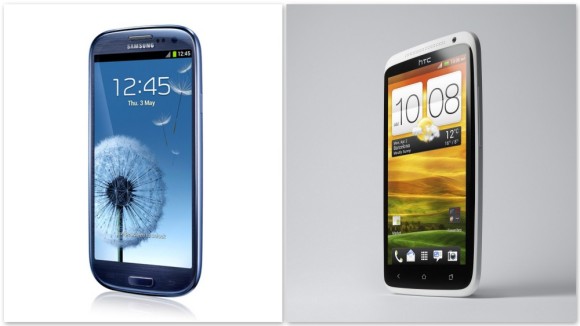The recent launch of the new Samsung Galaxy S III has once again ignited the battle for the throne of Android supremacy.
This new model will have as its main contender the HTC One X, since the Galaxy Nexus is already looking a bit dated in this fast-moving world of smartphone launches.
They have very similar technical specifications, so we will have to wait for comprehensive benchmarking reports between these two Quad core, Ice Cream Sandwich packing beasts. In the mean time, let’s look at what is setting them apart.
1. Storage capacity
The HTC One X does not allow for an immediate battery replacement or indeed the insertion of a microSD memory card to increase the 32GB internal memory. Still, in the British market, this model is being offered with 25GB of Dropbox online storage (free for 2 years).
On the other hand, though, the Galaxy S III has various internal memory capacities (16GB, 32GB and a 64GB promised down the line), aside from the possibility of being able to extend this memory with a microSD card. One of the main mobile phone retailers is already accepting pre-orders of the 16GB model with the offer of a 32GB microSDHC card. Waiting for the flagship model means a possible increase in total memory up to 96GB! Plenty of high-definition photos and videos to see and share, I’d say…
Samsung 1 – HTC 0
2. Processing efficiency
The Samsung model features their new 1.4 GHz Exynos Quad core 32-nanometer processor, which is more modern than the HTC’s 1.5GHz Nvidia Tegra 3 Quad core 40-nanometer processor. Yesterday’s benchmarking report by Slashgear demonstrates the S III’s very impressive figures. Until a definitive benchmarking test proves otherwise, the Samsung processor is likely to be more efficient than the HTC, despite seeming less powerful on paper.
Samsung 2 – HTC 0
3. Battery life
The Samsung battery is 2100mAh against HTC’s 1800mAh. Consumers will indeed have something to say about claims by HTC executives that say smartphone thinness is a priority over battery life. Recent tests show that the latter’s processing power has a definite impact on the battery life, which is the Achilles heel of the Taiwanese model. Given that Samsung’s battery can be swapped for a fully charged one, the S III seems to have the upper hand in battery life.
Samsung 3 – HTC 0
4. Image capabilities
Finally, when comparing the image capabilities, we are thinking both in terms of the quality of the screen and the hardware and software driving the photo and video capabilities of these models.
When it comes to screens, Samsung’s slightly larger 4.8″ HD Super AMOLED is a strong competitor to HTC’s 4.7″ IPS screen. The benefits of the latter include excellent viewing angles and great picture quality. As we know, smartphones’ screens are the most important factor in terms of battery drainage. With a hands-on comparison between the two, we will be able to make a better call on this one. Let’s just hope the colour spectrum on the S III don’t have the over-saturated look of the S II.
As for the cameras, we’re looking at a 8MP camera for both models, with 1280 x 720 display resolution and 1080p HD video recording. However, the S III has a 1.9MP front camera versus the 1.3MP One X. As we’ve seen though, Samsung will have a hard time topping HTC’s impressive Imagesense technology, which is boosted by a fast f/2.0 lens, allowing for shorter exposures and clearer snaps of moving subjects.
So unless Samsung ups the game in terms of real-world image capture, HTC’s image capabilities are the closest competitor to Apple’s iPhone 4S claimed leadership.
Samsung 3 – HTC 1
5. Sound and audio
It’s strange that not much has been said about Samsung’s audio capabilities. Given that consumers are making the most of the increased internal storage to use their smartphones as portable media players, this is increasingly a deciding factor in their list of priorities when comparing models.
Given the inclusion of the very popular Beats Audio system in the HTC One X, we have to assume that Samsung will have difficulty in ‘beating’ the excellent sound HTC is boasting, especially when matched with the appropriate headphones.
Samsung 3 – HTC2
6. In summary
Both these Android beasts are packing serious hardware and specifications that would make any gaming or intensive multi-tasking app session a breeze. As for the HTC Sense and Samsung TouchWiz interface that are latched on to the Android OS, it’s a matter of personal preference. I for one have a few grudges against HTC Sense’s buggy interface, especially when it comes to moving apps to the memory card, as opposed to using up the phone’s internal storage.
Both the current Samsung homepage as well as the HTC product page for their new flagships showcase the consumer-focused technology that capture a consumer’s imagination, with the former clearly preferring to highlight its quirky S Voice, Social tag and S Beam functionalities, which all aim to be clear contenders for Apple’s Siri, iPhoto and iCloud solutions.
The Samsung seems to be the more well-rounded of the two, especially in terms of ease of content sharing, whereas the HTC is likely to be the delight of people who want the best possible audio and video capabilities in an Android mobile phone.
I’ll be waiting earnestly to read the first benchmarking tests between the two models, which should be performed closer to the sale date of the new Samsung towards the end of this month. And may the best Android phone win!


